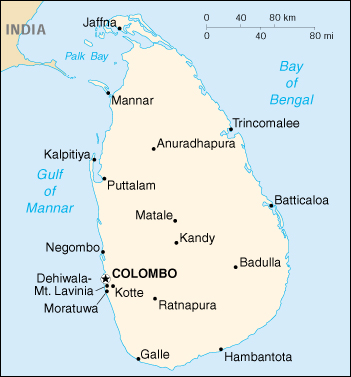

Status Quo Side: Sri Lankan Sinhalese government
Non-Status Quo Side: Tamil Tiger rebels
Region: South Asia & SW Asia
Conflict Type: Primarily Internal
Issues in Dispute: Ethnic, Governance, Independence
Tensions between the predominantly Buddhist Sinhalese majority and the predominantly Hindu Tamil groups in the east and north, barely 20 miles from India's own Tamil Nadu region, date from the Middle Ages. Under British rule so-called Jaffna Tamils and other minorities disproportionately represented the elites. Independence and elections in 1956 unleashed Sinhalese chauvinism. Sinhala became the sole national language, the economy favored Sinhalese business interests, and Tamils were purged from government. Disturbances escalated in the late 1960's.
The radical Sinhalese People's Liberation Front's (JVP) attempted coup was repressed at huge cost. Meanwhile the violent Liberation Tigers of Tamil Eelam (LTTE) engaged in terrorism and assassinations. Sinhalese nationalism abated when Premier J.R.Jayewardene sought reconciliation.
A deadly Tigers raid on a Jaffna army post in July 1983 sparked massive Sinhalese rioting in Colombo, killing 1,000 and displacing 100,000. Tamil parliamentarians were expelled, Tamils flocked to LTTE and other rebel groups and incidents multiplied. By December 1985 the Tigers controlled Jaffna, Sri Lanka's northern capital. New leadership and a 1700 % defense budget increase transformed the army. In April 1987, after Tigers massacred 128 Sinhalese, the army launched "Operation Liberation" against northern guerrillas. Prime Minister Rajiv Gandhi's India, under Tamil Nadu pressure, sent 45,000 peacekeepers. A cease-fire was achieved in 1987.
Promised considerable autonomy in the north and east, the LTTE surrendered much of its arsenal and agreed to Indian withdrawal. The JVP violently protested the concessions.
The suicide of Tamils under arrest inflamed ethnic relations, and the LTTE renounced the July accord. Violence resumed.
The rebels disarmed and accepted a cease-fire in June but India, not consulted, refused to acknowledge it. In mid-1990 India withdrew.
The Tigers launched a bloody attack with substantial casualties, matched by continuing slaughter by the radical JVP of thousands of young Sinhalese. The President was assassinated by a Tamil suicide bomber on May 1, 1993, followed by other assassinations. The 1994 presidential election was won by Chandrika Kumaratunga who named her mother, Sirimavo Bandaranaike, to succeed her as prime minister and began peace talks with the Tamil rebels. In 1995 the government lifted the 1990 embargo, but in October rebels blew up 2 naval vessels and on December 5 government troops took control of Jaffna city.
In retaliation a massive truck bomb devastated Colombo's financial district on January 31, 1996 and battles raged between the sides. In May 1996 government forces claimed to have reclaimed the northern Jaffna peninsula and launched a major offensive against the Tamil strongholds. The reform package that would give autonomy to the Tamils continued to be rejected by the Tigers and stalled by Mrs. Kuma ratunga's Sinhalese opponents, and in January 1997 the Tigers overran a stategic government base. While President Kumaratunga continued her 2-track policy of peace plus counter-attack, by 1998 the 14-year war had taken 80,000 lives.
In the fall of 1999 the insurgents retook much of the territory captured by government forces in 1995 and 1996, losing 500 troops. In the December 21 presidential election, the guerillas launched suicide bombing attacks in Colombo, killing 36 and wounding 187 including President Kumaratunga. In January, 2000, other bombings took place in the capital. Despite government overtures under the re-elected president, the rebels seemed uninterested in negotiation and prospects for peace seemed dimmer than ever.
[Lanka.net Sri Lanka web server with links to news sources, etc.]
[Spotlight on Sri Lanka with news links]
[US CIA Factbook 2000]
[Peace Brigades International project archive 1989-98]
[US Department of State country background notes 1995]
[Library of Congress country study of
Sri Lanka 1988]